![]()
![]()
![]()
Use LEFT and RIGHT arrow keys to navigate between flashcards;
Use UP and DOWN arrow keys to flip the card;
H to show hint;
A reads text to speech;
28 Cards in this Set
- Front
- Back
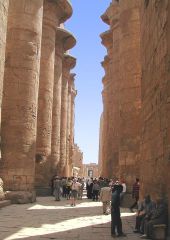
What is this? How is it designed?
|
Temple of Amen-Re, Karnak
NEW KINGDOM PERIOD •Axis is running all the way through the building just as the Temple of Horus •There is a hall with a lot of columns; shorter and then taller—capital of shorter columns represents a closed bud of a papyrus, the taller are those that are in bloom o Element of the creation and the God’s first involvement with earth |
|

What is this? How is it designed? Who designed it? What is the design's significance?
|
Mortuary Temple of Queen Hapshetsut built by Senmut
*Axial symmetry dividing the temple *Trees were planted on each sides of the ramp (FIRST EVIDENCE OF LANDSCAPE ARCHITECTURE) *The architecture has a good relationship with the setting |
|
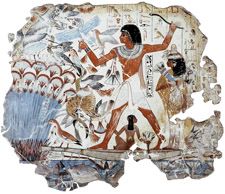
What is this? What is happening? What is the art like and why is it significant?
|
Paintings from Tomb of Nebamun; Fowling Scene
NEW KINGDOM PERIOD *There is a definite difference between the art styles of the human and the animals. The animals have very naturalistic features in terms of texture, size, and shape. Whereas the human has a black outline, non-individualistic pose (right foot in front, no shading, etc) |
|
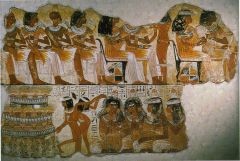
What is this? What is its significance?
|
Paintings from Tomb of Nebamun; Musicians and Dancers
NEW KINGDOM PERIOD *On the top row, all are seated with the same pose in the same direction suggesting a higher class of society *The front views of the musician's faces and bottoms of feet are shown--unconventional for Egyptian art but suggests a lower class of society which allows rules to be broken |
|
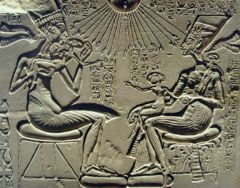
What is this called? Explain the style of the piece and how it is different from the traditional Egyptian style.
|
Akhenaton, Nefertiri, and Three Daughters
NEW KINGDOM PERIOD •Akhenaton is shown with his prominent belly over the dress •Shown with three of their daughters; a family scene •Basking in the rays of Aten, showing the connection between the God and Akhenaton’s family •Do not look as stiff and formal as other traditional styles from an earlier time period |
|

What is this and what is the significance of other objects such as this? Who discovered this?
|
Objects from the Tomb of Tutankhamen
NEW KINGDOM PERIOD •Short reign, but famous because his tomb is the only one that has survived until modern times oThe opening had been covered up so debris had covered the entrance oHoward Carter, an archaeologist from England, found the tomb oExcellent demonstration of workmanship and quality of the time period oBasks in the sun disk of Aten on the back of the throne •convinced to bring back the old religion because the word “amen” is in his name, the capital moves back |
|
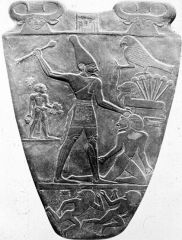
What is this? What is its importance and why is it artistically significant?
|
Palette of Narmer, c. 3000 BC
OLD KINGDOM PERIOD •Thought to be a make-up case for a man (i.e. mascara) named King Narmer •Hierarchy of scale; Narmer is emphasized in size and importance •Lions symbolize royal authority •Bull charging into a city wall oRepresents the capture of an enemy city oBull=pharaoh •Narmer is wearing the crown of Upper Egypt oIs about to sacrifice the man in his hands as a offering to god (Horus) oVictory of the lower Egypt as shown with the lower Egypt club in Horus’ talons •Typical human stance of Egyptian art (Similar to Near Eastern) oConceptual and conceptual physiology Standing open-shouldered Feet apart, left foot forward Same proportions for every one •NO INDIVIDUALS •Used canons (grid system) to make the human figure |
|
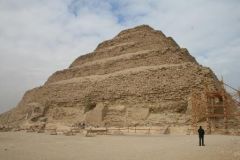
What is this? Who built it? What is its significance and artistic significance? What period is it in?
|
Stepped Pyramid of Djoser, Saqqara, Architect: Imhotep;
OLD KINGDOM PERIOD •Surrounded by storage buildings to help sustain the dead in the afterlife oMummification process was only to help sustain the hope of resurrection for the dead; they were able to see their body remain intact •Levels/steps constructed out of stone (first time stone is ever used in Egyptian history) to preserve through the eternities •Building phases were determined oFirst, Mastaba for the base, then it was extended oThen created Mastabas one on top of another to create height oNo interior spaces, only serves as a grave marker oBelow ground level is where the burial chamber existed |
|
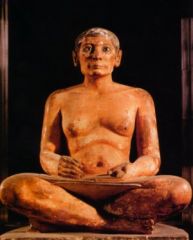
|
Seated Scribe, C. 2450 BC
OLD KINGDOM PERIOD •Found in a tomb belonging to Kai, a court official •More of a natural pose oLively expression oPreserved paint oMore realistic Formal style is only reserved for higher officials of society |
|
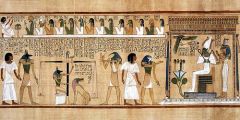
|
Last Judgement of Hu-Nefer, Painted Papyrus Scroll from his Tomb, ca. 1285 BC
NEW KINGDOM PERIOD • Knubus is carrying an ark (symbol of life) and is assisting Hu-Nefer to the afterlife • Judgment is represented by a scale; to determine the worth of his soul o One side is a jar with his heart and it is being weighed with an Ostrich feather (goddess Maat of Judgment) • Is then presented to Osiris, the god of the underworld |
|

|
Female Figures (Folded Arm Figures--Spedos Type), c. 2500 BC
CYCLADIC PERIOD • Consist of marble • The pose of the arms folded across the body imply something unknown but they are not idols • Abstract style of carving; only the nose is the prominent figure • Spaedos type of chin—well rounded • Overall is a long figure, never very naturalistic in terms of showing correct proportions |
|
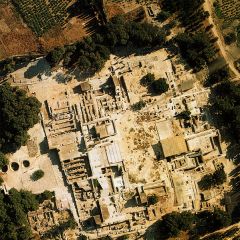
|
Palace, Knossos, c. 1600-1400 BC
MINOAN PERIOD • More of a city, found on a hilltop possibly for protection since there is no wall around the complex • All palaces of the time period have a rectangular courtyard in the middle of the layout, aligned north to south o Layout suggests rooms were added over time o Bottom ruins with square archways suggest a relation to the architecture of the Egyptian Mortuary Temple of Hatshepsut o Did not borrow fine masonry from the Egyptians • Are in major ruins o Construction techniques used by the Minoans were not very sturdy • A monumental staircase suggests it is leading to a room of importance • There is a room with large vases used for food • There is not a separate room/structure used for religious practices o Suggests a lot of Minoans utilized the outdoors for religious practices o Almost always are women taking the ritual role within religious practices • Minotaur and the Labyrinth o A lot of the architecture suggests a relation to the myth—a series of corridors are harmonious to the complications of the building layouts o A double headed axe is from the root of labyrinth |
|
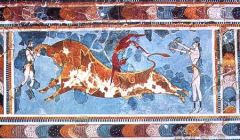
|
Bulleapers (Toreador) Fresco, Knossos
MINOAN PERIOD • The darker pieces are the original pieces • Bull is in the flying gallop suggesting it is running • The three figures suggest a progressive bullfight—grabbing of the horns, flipping over the bull’s back, to standing behind it • Minoans used the same techniques of fresco paintings as the Egyptians o Profile shots of the body o Not everything is copied exactly, much more free with the use of lines |
|
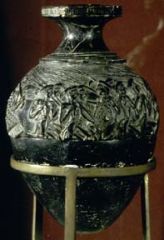
|
Harvester Vase, c. 1500 BC
MINOAN PERIOD • Men are all wearing a short kilt • Some are in a combination pose with only profiles showing o Difference between the Near East and Egyptian is the fact there is definition of muscle; more naturalistic with these kinds of details (first art that shows naturalism) • This would’ve been used to make some sort of offering because the bottom has no real base for standing on its own |
|
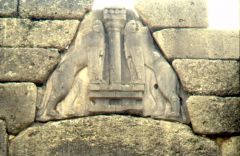
|
Lion Gate, Mycenae, c. 1,300 BC
MYCENEAN PERIOD • The arch-like shape is called “Corbelling” o To help support the arch in distributing the weight of the stone on top of the arch • Relief sculpture of lions which probably has some religious symbolism/significance o Lions are symbols of power |
|
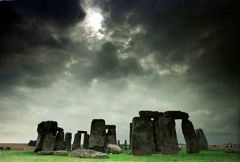
|
Stonehenge, near Wiltshire, England, c. 2,300 BC
NEOLITHIC PERIOD Megalithic · Most famous “cromlech”: a circle of stone · Encompassed by a series of circles which obviously direct to the central point · Post and lintel elements of architecture and structure o Making of stories like on buildings · Rocks begin standing 3 feet below ground · Quarry was from Wales 130 miles away o This site was chosen for a particular reason! · A couple of years ago, graves were found scattered around its perimeter · Argued that it may deal with celestial/ astronomical events such as the summer solstice |
|
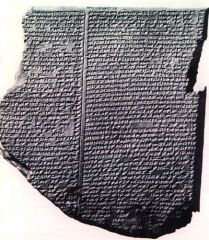
|
Epic of Gilgamesh
MESOPOTAMIAN ART *With the development of cities come the development of laws, government, sophisticated communication and writing. The earliest writings concerned record keeping (cuneiform—use of symbols) but then brought on the development of literature and storytelling (i.e. Epic of Gilgamesh) · Storytelling, writing ==> further development of religion o People trying to understand the world around them and have different explanations of natural phenomena o Cults form, political groups begin to create as thought and communication advance |
|
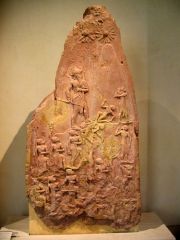
|
Victory Stele of Naram-Sin, c. 2300-2200 BC
AKKAD PERIOD Relief sculpture Celebration of a military victory of Naram-Sin, who is depicted in greater size than the other people in the relief Hierarchy of scale Naram-Sin is thanking the deities at the peak with his soldiers in rank behind him Shamash: sun god, primary Ishtar: goddess of love, beauty, marriage, and war Could not win without their support Rounded physical features of the arms is typical of Near Eastern art |
|

|
Funerary Mask of Agamemnon, c. 1600-1550 BC
MYCENEAN PERIOD * Possibly influenced by Egyptian burial techniques of using death masks * Made of solid gold * Do they suggest individual portraits and specific characteristics? |
|

|
Warrior Vase, c. 1300-1100 BC
MYCENEAN PERIOD *Vase is divided into zones *The soldiers are cartoonish, but have the same simple facial features *The art is more abstract than Minoans |
|
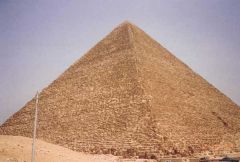
|
Khufu (Cheops), c. 2530 BC
OLD KINGDOM PERIOD *Largest pyramid *510-11 feet tall; 51 stories when it was first built *2-3 tons per brick, quarry was near the site *The lower burial room was never finished, the upper rooms (king and queens chambers) were finished *Weight was being pushed away from the center, inner rooms by constructing the stones in a capital A shape *The shafts that are perpendicular to the sides point either to the North Star and the Constellation of Orion/Osiris |
|
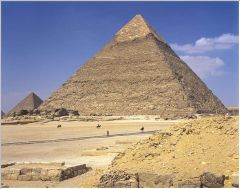
|
Khafre, c. 2500 BC
OLD KINGDOM PERIOD *Limestone front is still preserved on the top *Over the centuries, stone was taken from the fronts of the pyramid to construct other buildings, structures *A more simplified version of Khufu in terms of interior space *How were they built?? *Historical documents do not exist; construction method is unknown *The form of the pyramid *Same shape that is on the top of the obelisk *Symbolizes the rays of the sun; the pharaoh will ascend into the sun |
|
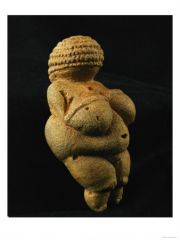
|
Venus of Willendorf, c. 24,000 BC
PALEOLITHIC PERIOD *Venus is a modern title (Greek root) because it has some association with fertility *Emphasized by the swollen breasts, wool cap, and larger belly; not completely realistic proportions *The epitome of fertility because she is healthy—an element that was critical for survival *Having children and a family, they were important to help hunt, farm, and for aid while getting older *Not being to have children was essentially life-threatening |
|
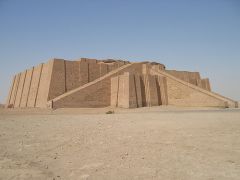
|
Ziggurat at Ur, Iraq, c. 2,100-2,050 BC
NEAR EAST PERIOD *Battered walls=sloped in walls which give stability *Doesn’t have a central room on top but is just a platform to elevate priests closer to the gods *A text that survived said that these ziggurats were constructed to be used by the gods to “step down onto earth” *A place where heaven and earth meet |
|
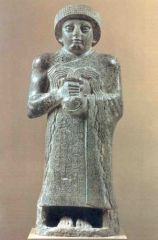
|
Gudea, c. 2150 BC
NEO-SUMERIAN PERIOD *Diorite stone figures; not quarried in the Near East but in Egypt *Will maintain its detail—wanted to last through the eternities *Clasping hands in gesture of prayer *Wanted to show his piety and devotion to the Gods; to demonstrate his role as a leader *These kinds of statues were mainly distributed to temples *In his lap, there is a tablet with a building plan. Apparently, it was revealed to him that he needed to construct a building *Does not follow normal proportions of the human body |
|
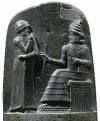
|
Stele of Hammurabi, c. 1780 BC
BABYLONIAN PERIOD *Code of Hammurabi *Instructions by the gods to reform the laws *First time in history law is recorded *In the relief, Hammurabi is trying to demonstrate that he did not come up with the code, but the gods did and he created them under their direction *With his hand up near his mouth, it is suggested that they are discussing the law that is created in the code *The rod is a symbol of justice *Rulers have a special connection with the gods |
|
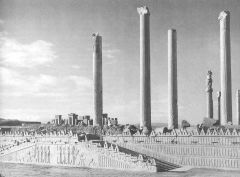
|
Palace of Darius and Xerxes, Persepolis, c. 500 BC
PERSIAN PERIOD * Rows of columns suggest limitations in the post and lintel system (what kinds of material, material’s strength) *Raised platform—king on a higher level than the citizens *Reliefs on the edge of platform show ambassadors visiting the palace *It will be a later time period when large areas can be created using columns and FEWER of them |
|
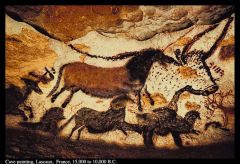
|
Cave Paintings, Lascaux, France, c. 15,000 BC
PALEOLITHIC PERIOD *After it was found, mold started growing cause of the temperature of the cave was starting to rise with more and more visitors. *Found throughout the cave, not just at the opening *Different sizes of animals suggest they were done at different times *NATURALIST DETAILS *Rare to see any human figures at all |

